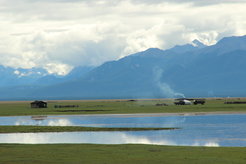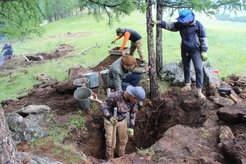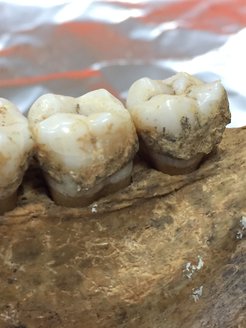Life Under the Mongol Empire: Transmission of Commodities, Cuisine, and Disease
The Mongol Empire stretched from eastern Asia to the borders of Eastern Europe. This period was marked by globalization of commodities, technologies, and ideas, which spread alongside invisible pathogens and microbes. However, we know little of the cuisine and health of Mongol period populations, even as historical texts document goods flowing into modern day Mongolia from across the Empire. Our excavation and analyses of human remains will focus on clarifying the dietary intake, cuisine, and health of a population that lived under the Mongol Empire.

Our team from the MPI-SHH, in conjunction the National Museum of Mongolia and NOMAD Science, will lead a bioarchaeological field school as part of a rescue excavation to recover and conserve human remains from a Mongol period cemetery. As the cemetery has been looted, imported textiles and exotic commodities have been recovered. These findings suggest that this population was linked to exchange networks that introduced imported foodstuffs and cuisine alongside microbes and diseases.
Our biomolecular research focuses on several important issues for populations that regularly interact with other groups through ever expanding networks of trade and exchange. As globalization introduced commodities and cuisine, imperceptible microbes and pathogens were also transmitted. The impact of biotic exchange could negatively impact the population, while simultaneously creating resilient economies based on diversified diets.

Excavations of the looted Mongol period cemetery
This project seeks to clarify life under the Mongol Empire through the application of biomolecular methods including stable isotope analyses, investigations of ancient proteins in dental calculus, and ancient DNA of pathogens. These methods hold great potential for understanding how communities engaged with the Empire and how this impacted their lifeways.

Of particular interest is the consumption of milk and the domesticated species that were favored for milking. The role of pathogens in the rise and fall of the Mongol Empire is also of significant interest, particularly as disease plays a major role in building sustainability. This project also explores cuisine and dietary intake through isotopic and proteomic research. Our aim is to understand these populations in terms of their biomolecular history at the intersection of diet, cuisine, and disease.
Related Publications
Wilkin, S., Ventresca Miller, A., Miller, B. K., Spengler, R. N., Taylor, W. T. T., Fernandes, R., Hagan, R. W., Bleasdale, M., Zech, J., Ulziibayar, S., Myagmar, E., Boivin, N., Roberts, P. 2020. Economic Diversification Supported the Growth of Mongolia’s Nomadic Empires. Scientific Reports. 10:3916. doi: 10.1038/s41598-020-60194-0.


